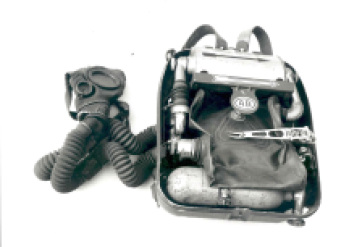What We Did During the War: Henry Rex Marrett

Henry Rex Marrett (1912-2003) trained at Bart’s, qualifying in 1940, and joined their anaesthetic department, then led by Langton Hewer. The department was testing trilene and its uses as an analgesic, and offered Marrett the opportunity to combine anaesthesia with his life-long interest in engineering. Though trilene was an effective analgesic and could be used to induce and maintain light anaesthesia, a muscle relaxant was also required for abdominal surgery and heavier anaesthesia. In order to meet these requirements, Marrett used two Walton bottles- one for trilene and one for ether- and an oxygen tap and created an easily portable anaesthetic machine. He took this machine with him when he joined the Royal Army Medical Corps in 1943.

German mine rescue apparatus
However, Marrett had to abandon this machine when he found himself in an area of German occupied France. Whilst in Normandy, Marrett discovered a closed-circuit rescue apparatus from a mine. Borrowing a soldering iron, he adapted it into a close circuit anaesthetic machine. Both of his devices caught the attention of senior surgical and anaesthetic officers who noted that it was more effective that the equipment they had been issued. At the end of the war, Marrett was relieved of all other duties for nine months and ordered to produce an anaesthetic machine suitable for use in the field by the military. His name was later placed on a list of wartime inventors and in recognition of his work, he received £450, with which he bought a caravan.